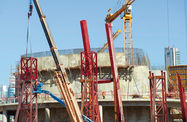Momentum generated by a strong recovery in Kuwait’s real estate sector in early 2012 is expected to continue throughout the year.
In February 2012, the National Bank of Kuwait revealed that real estate sales in January totalled KD318.1m ($1.14bn), a 64% year-on-year (y-o-y) increase, which represents the third-best level on record.
While the residential sector accounted for 54% of total sales, the commercial and investment sectors also saw healthy growth, according to the NBK. Residential sales reached KD170.3m ($609.35m) in January, a 40% y-o-y climb, and the investment sector – which mainly consists of apartments and buildings intended for rental – saw KD127.3m ($455.49m) in transactions. Furthermore, a report by Al Shall Investment, a local consulting company, released in February, stated that KD186m ($665.52m) was spent on new houses in January.
The surging sales reported by NBK represent a major improvement from figures at the end of 2011. In December, the bank noted that sales activity the month previous reached KD138m ($493.75m), a drop of 4. 2% y-o-y, and a larger fall of 47% month-on-month.
The renewed confidence in the market has been assisted by regulatory tightening and the government’s spending plans. The KD37bn ($132.39bn) Kuwait Development Plan – the country’s first since 1986 – is expected to generate growth in the residential sector, while the Kuwait Investment Authority plans to invest KD1bn ($3.58bn) in the commercial and investment segments.
Specific projects currently under development include the $77bn Silk City project, which will create a 25,091-ha metropolis close to Kuwait City. The project, which is expected to be completed by 2023, also includes plans for the world’s tallest tower at 1001 metres.
Other major infrastructure projects expected to accelerate growth in the real estate sector include the 22.5-km Al Ahmed Bridge, which will cost KD733m ($2.62bn) and connect Silk City with neighbouring Kuwait City, and the $1.1bn Bubiyan Port project. In April 2011, the Kuwaiti government also revealed it was seeking a consultant for a $25bn railway project.
In addition to these so-called “mega-projects”, Kuwait also plans to begin implementation of a low-cost housing project, with an estimated budget of KD100m ($357.81m). However, in January, Mohammad Al Numas, the state minister for housing affairs, admitted that funding for the project remained “hazy”.
A major contributor to the expansion seen in the residential market in January was the high number of transactions, said NBK, with the 806 completed representing a four-year peak for the sector. The majority of the sales (71%) were for plots of land, as opposed to finished homes.
Although the investment sector has historically trailed the residential sector in monthly sales value, NBK said, “it continues to be a major factor in the recovery of the real estate sector as investors look for income property and investment alternatives”. The commercial sector recorded eight transactions in January, totalling KD20.5m ($73.335m), an increase of KD11.5m ($41.15m) from January 2011.
Further evidence of the recovery is seen in the findings of Business Monitor International (BMI). A February BMI report stated that “the office market – in spite of historic oversupply – is posting steady growth rates which ... have settled into a positive growth trajectory ... BMI believes that retail holds the greatest potential in the longer term due to positive underlying fundamentals.”
Residential and office space aren’t the only areas primed for growth: as noted by OBG in January, Kuwait’s largest mall and shopping centre, The Avenues, is currently building a $500m extension, which is scheduled for completion by September 2012. The mall’s third-phase expansion will cover approximately 100,000 sq metres, extending The Avenues’ total area to 420,000 sq metres.
With growth in sales of commercial, residential and investment property strong and leaders tightening the regulatory framework, the Kuwait real estate sector can be expected to ride the wave of expansion being driven by government spending, which it should begin to capitalise on in the coming years.

